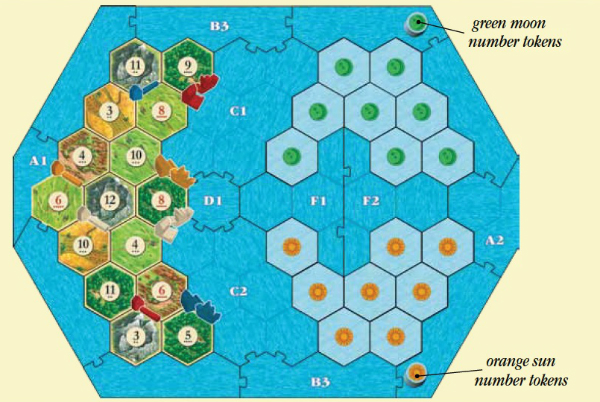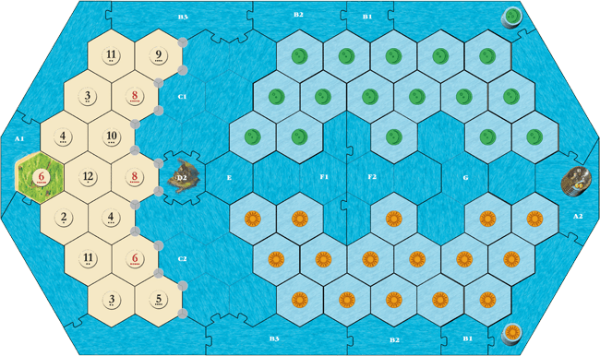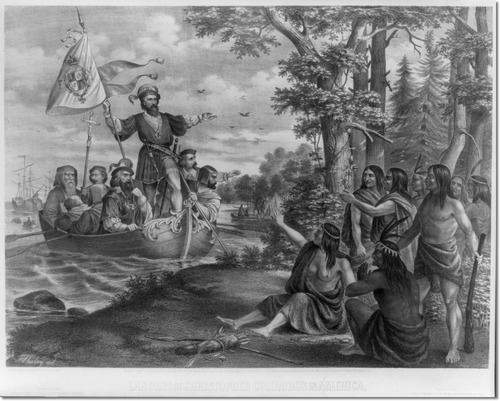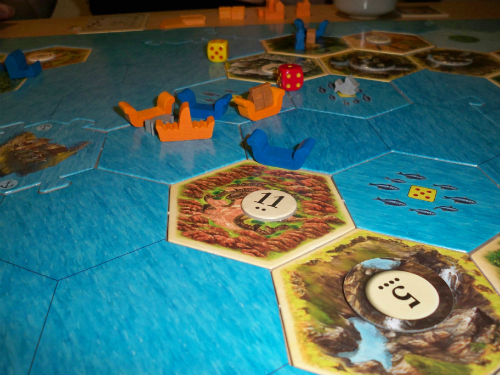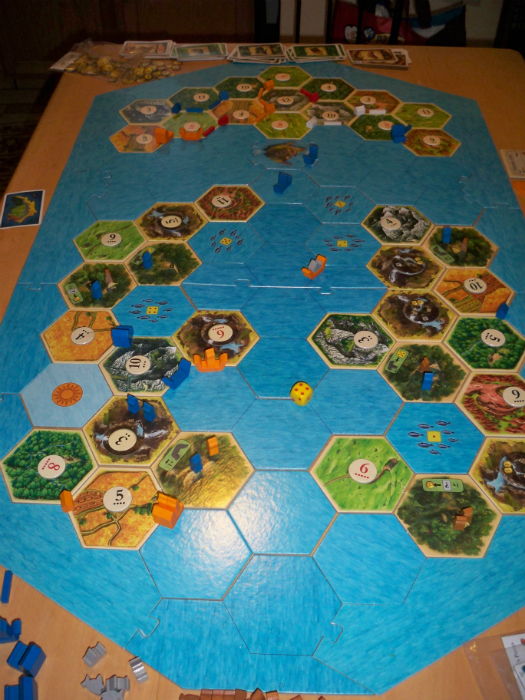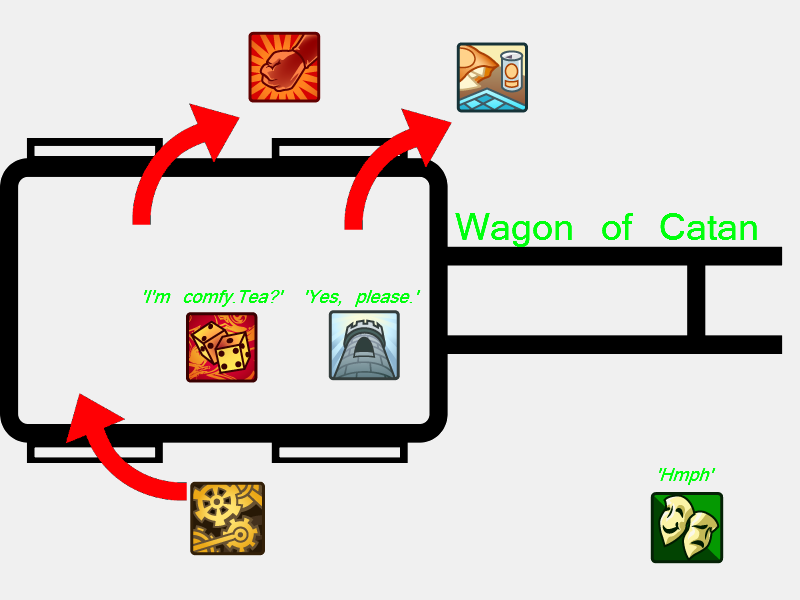Note: This review pertains to a large expansion for Settlers of Catan and requires the base game to play. We are also assuming that you are familiar with the base game, or at least have read its review.
Settlers of Catan has enjoyed enormous popularity since its release almost 20 years ago, spawning numerous spinoffs like the quasi-historical reskins of Egypt and China, the Catan Card Game, and Catan Dice, to say the least. There have also been numerous expansions and one-shot scenarios designed, each bringing its own spin to the now-iconic game. Whether becoming stalwart Seafarers, dealing with feudalistic Knights, or combating annoying Barbarian hordes, Catan has gone through a lot and continues to thrive. How much more can this little island handle? Well, as it turns out…quite a bit.
The Premise
The island of Catan has been fully settled. The burgeoning civilization has explored the boundaries of their new land, weathered the hazards of Barbarians, expanded their cities, and have begun making excursions into the nearby archipelagos in search of new resources. While establishing sea routes among the smaller islands to the west, news has reached the Council of Catan of larger landmasses to the east, peopled by advanced natives and dangerous pirate fortresses. The Catanese have always been explorers and wandering merchants. The challenge presented by a strange new frontier has proved an irresistible lure, and the Council has sent players out to explore, trade, and make names for themselves.
The Rules
Catan: Explorers and Pirates heavily expands and modifies the base game, Settlers of Catan, introducing a host of new rules and objectives. These are revealed over the course of five scenarios and three map sizes so as not to overwhelm the players all at once; it gives the game the feel of a video game’s tutorial levels.
Which components used from the base Catan and/or Explorers and Pirates depends on the scenario played, and the full rule book will specify the details of each scenario. However, it should be noted that players will require a slightly larger playing area and a slightly higher time commitment than Settlers of Catan does alone.
The scenarios vary in terms of goals and strategies, but Catan: Explorers and Pirates introduces or alters a number of mechanics. These include:
- Gold: Gold has been added as a secondary resource. If players don’t collect resources from a die roll, they receive Gold as compensation. Players also receive Gold by revealing unexplored map tiles. Gold can be traded like resources, cannot be stolen, and twice per turn two Gold may be exchanged for a resource.
- Generic Trade: Traditional ports have been removed. As a result (and to show the expanded economy of a Catan that can afford a Ruling Council that sends out expeditions), players may now trade resources for resources or Gold at a 3:1 rate, rather than the original 4:1.
- Pirate Ships: Pirate Ships are basically a sea-based Robber, but instead of halting production, opponents’ Ships must instead pay a tribute of Gold to pass them.
- Ships: The hallmark of this expansion revolves around, well, exploring. This is done through Ships. Costing a Wool and a Wood (Sails and Hull), Ships travel at a rate of four edges per turn, transporting various goods across the map. Each player is limited to three ships, and ships may only carry one commodity at a time.One of things Ships carry are Settlers, who are transported to a coastal land tiles to create a Settlement. Settlers let players expand into the smaller islands discovered throughout the game.
Ships and Settlers are built at Harbors, an upgraded coastal Settlement that produces and receives some of the cargo Ships carry. Replacing Cities, Harbors are still worth two VP, but unlike Cities, they only produce one resource of a tile they border.
Because of the way Ships explore and plant Settlements, gameplay has been broken up into three phases: Resource Production, Trading/Building, and Movement. The first two phases behave the same as in normal Catan. Movement includes the use and actions of Ships, and it is where much of the expansion’s focus takes place.
In Explorers and Pirates, tiles past the starting island begin unexplored. What players are exploring for exactly varies with the scenario being played, but the goal remains to achieve the most VP. Each scenario comes with their own objectives and VP conditions. Replacing Development cards and the special victory cards are three new options for VP, each with their own means for tracking progress: Pirate Lairs, Fishing, and Native Diplomacy.
- Pirate Lairs are Gold-producing tiles that cannot be settled until players chase them off, earning VP in the process.
- Fishing is…exactly what it sounds like. Players ferry their catch back and forth to feed the citizens of Catan, earning VP for successful deliveries.
- Native Diplomacy also earns VP, but becoming friendly with the Native Tribes by engaging in a Spice trade also provides players with permanent and potentially powerful bonuses.
For all of the alterations made, players still take turns and progress through the game in the familiar Catan manner until one player reaches the VP amount specified in the scenario. Once that happens, that player becomes the Christopher Columbus of Catan. Everyone else is relegated to taking up fishing or piracy as they’re pushed to the sidelines of history.
New Siblings To The Family
Explorers and Pirates feels more like a completely different game than a mere expansion. Rather than a race to expand before your opponents completely hem you in, the unknown exploration gives this game a much grander feel as players blindly race their ships away from Catan to points beyond. The use of Roads is almost nonexistent, the starting island does not encourage a network of any kind, and your island Settlements will not often be linking up to each other. It’s bigger than that.
For starters, we particularly liked the inclusion of Gold. It’s a limited mechanic that gives a massive boost in the early game, and it keeps players from being shut out by bad rolls. (No one likes seeing someone sit there turn after turn because no one is rolling a six or eight.) Yes, unfortunate rolls can still hurt you, but now you’re at least getting something. However, this influx is by no means constant. For example, your Ships can just sit one tile away from delivering their goods for several turns because you lack the Gold to pay tribute with. Pirates are mean like that.
Incidentally, Gold tribute is paid to the supply, not the player who owns the Pirate Ship. We assume this is for balance reasons, but it only seems fair that a player gets a cut of the take from their privateer. Alas.
Speaking of pirates, the Pirate Lairs are interesting as it experiments with the idea of cooperative conflict. Multiple players can jump in on the same Lair, forcing one another to share its VP.
But fear not – your Crews cannot fight each other, so this doesn’t descend into Battles of Catan. (Still, being able to claim the title of Greatest Pirate Scourge can be its own reward.) In fact, because of the expansive map and decentralized territory, there is even less indirect conflict than the base game.
Fishing is an exercise in juggling duties. When you only have three Ships to shuttle around Fish, Spice, Settlers, and Crew, you’ll likely need to dedicate one just for hauling food. While simple in concept, it requires careful planning so as not to hamper yourself. This exemplifies just one reason among many why you’ll likely see everyone’s first goal in the game is to build a second Ship, whether it’s for fishing, exploring or quickly building another Harbor.
Mechanically, though, the Native Islands are by far the most influential one of the new three, allowing a player to surge from last place to first just by the luck of stumbling across a few powerful bonuses before everyone else. Villages can let you trade resources at a cheaper rate, chase away pirates more easily, or increase your Ship speed. There are two bonuses of each kind, and the effects stack. These permanent bonuses can be gained by all the players (it is not possible to shut someone out of a Village), but a few rounds where you have the advantage can make all the difference.
However, thematically it’s not clear why “Spice” is used as the measure of VP on the Native Objective Track, as unlike Sheep or Wood, each “Spice” is a one-time-use, non-renewable piece. It could as easily be called “Treaty” and had the same effect. For most players this is immaterial, but it is flavor elements like that which Immersionists can get hung up on. As it stands, though, this group generally doesn’t favor Settlers of Catan to begin with, and the expansion offers little to alter their preference.
A Catan Cultural Exchange
Don’t let the structured look of the scenarios fool you. Explorers and Pirates has loads of replay value, and each scenario can be played repeatedly with different results each time – even more so than the original Catan. It even has a fairly balanced two player option. Explorers and Pirates was designed as a self-contained standalone expansion to the game with a variety of different setups, and in that it does a decent job. Be forewarned, though, that it is not intended to be used with other Catan expansions, and it’s designed for use with the 4th edition Settlers of Catan printing.
What makes Explorers and Pirates just as notable as its scenarios and increased scope is that the player audience significantly shifts. Game expansions usually just add new and challenging aspects to the core game, but Explorers dramatically alters Catan’s central premise of settling a single island. Strikers are one such affected group: while Settlers of Catan is a fairly random game, Strikers enjoy competing against other players in a confined space as they haggle and obstruct their way to the 10VP mark. With Explorers and Pirates, the challenge posed by time and territorial confinements along a singular path to victory is no longer there. They’ll feel that Explorers goes on too long for a game of Catan, and without the competition angle to preoccupy them, their issues with of randomness will resurface. As a result, they may not find Explorers and Pirates to be their Catan expansion of choice.
Similarly, while Settlers of Catan is a Gateway Game in the truest sense, Explorers is not. Explorers is a logical step for gamers who have grown beyond Catan’s simple focus, but the extra complexity and time commitment will have Socializers yearning for the base game.
The opposite happens to Tacticians. For a group that generally bemoans Settlers as too simplistic and linear, Tacticians will enjoy the wealth of new strategic options Explorers offers, and they will highly enjoy the light management needed to pursue multiple paths to victory.
Similar things can be said about Architects. While many Architects enjoy the concept that the base Catan provides, it’s always a game this group finds themselves on the fence about since they have to trade one resource for another, and the constant presence of the Robber makes amassing resources riskier than they’d prefer. With Explorers, Architects have a bit more freedom. They should enjoy the challenge of building their empire strategically to maximize the windfalls of profit.
In fact, the only archetypes that don’t seem to be affected with Explorers and Pirates, besides the still-unsatisfied Immersionists, are the Daredevils. The game is still pretty chaotic and unpredictable, and while games can go on longer, there is a lot more room to experiment here. They’ll see substituting one form of randomness for another a good thing as they’ll get to see where the dice rolls take them.
The Takeaway
When the developers of Catan: Explorers and Pirates released it, they made a rather bold statement. They said that if you only get one Catan expansion, it should be this one. As it turns out, this is a claim with merit. Explorers and Pirates is as varied as it is robust. It’s designed for Catan veterans looking to literally expand their horizons, but it still has the same inviting feeling.
It provides a number of new mechanics to the game that increases the need for increased strategy without taxing the interest of the game’s fan base. Explorers and Pirate spreads these mechanics out into upwards of five different scenarios of increasing complexity, affording players the flexibility to be as simple or as complex as they wish their game to be. No playthrough is ever quite the same as the one before – which you can start experiencing after awhile with the base game. Some folks may invariably prefer the core game, but if you’re one of those who enjoys Catan and would like to take it to the next step, you’ll want to set sail with Catan: Explorers and Pirates.
Catan: Explorers and Pirates is a product of Mayfair Games.
Cardboard Republic Snapshot Scoring (Based on scale of 5):
Artwork: 3.5
Rules Clarity: 4
Replay Value: 4.5
Physical Quality: 4
Overall Score: 4.5
Photo Credits: Christopher Columbus by Library of Congress.

